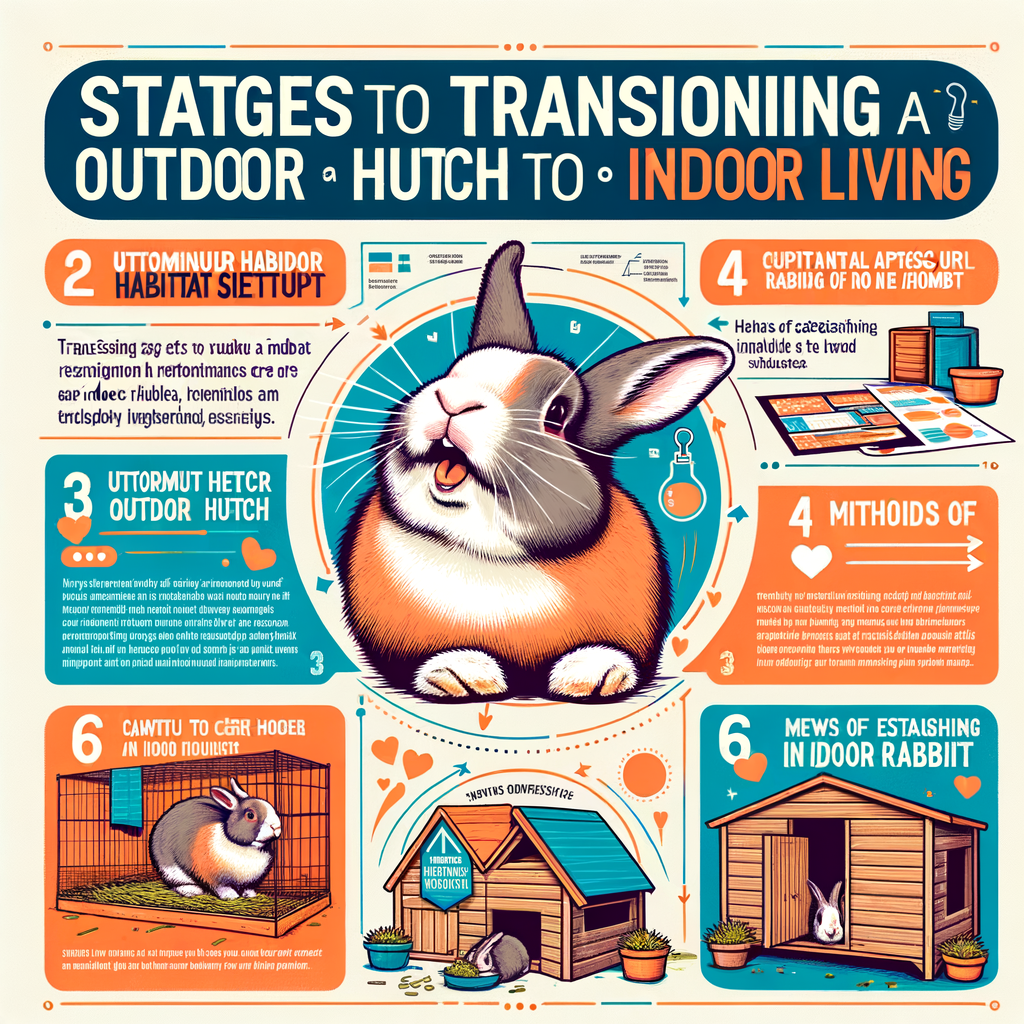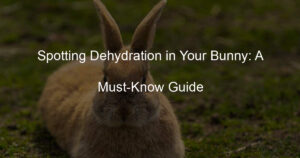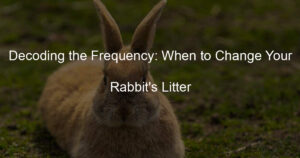
Introduction to Indoor Rabbit Care
Keeping rabbits as pets is a delightful experience, but it requires a good understanding of their needs, especially when they live indoors. This article aims to provide you with a comprehensive guide on indoor rabbit care.
- Understanding the Need for Indoor Rabbit Care
Rabbits are sensitive creatures that require a specific environment to thrive. While they can live outdoors, the indoor environment often provides a safer and more controlled setting. Indoor rabbit care involves creating a comfortable living space, providing a balanced diet, ensuring regular exercise, and maintaining their health.
- The Benefits of Transitioning Rabbits Indoors
Transitioning rabbits indoors comes with numerous benefits. Firstly, indoor rabbits are safe from predators, harsh weather conditions, and diseases common in outdoor environments. Secondly, they get more social interaction, which is essential for their emotional well-being. Lastly, indoor rabbits are easier to monitor, making it simpler to detect any health issues early.
However, it’s important to note that transitioning a rabbit from an outdoor to an indoor environment should be done gradually and with care. The following sections will guide you through the process and provide tips on how to make the transition as smooth as possible for your furry friend.
Whether you’re a first-time rabbit owner or looking to improve your rabbit care skills, this guide will provide you with the necessary knowledge to ensure your rabbit leads a happy and healthy life indoors.
Preparing for the Transition: Rabbit Hutch to House
Transitioning your rabbit from a hutch to a house can be a challenging task. It requires careful planning and consideration to ensure your rabbit’s comfort and safety. One of the most crucial steps in this process is choosing the right indoor rabbit housing.
Choosing the Right Indoor Rabbit Housing
When it comes to choosing the right indoor rabbit housing, there are two main factors to consider: space and size, and the type of housing. Let’s delve into these factors in more detail.
- Considerations for Space and Size
- Types of Indoor Rabbit Housing
- Cages: These are traditional options that come in various sizes. Ensure the cage is large enough for your rabbit to move around freely.
- Pens: Pens offer more space for your rabbit to play and explore. They can be easily expanded or reduced in size based on your available space.
- Free Roam: If your home is rabbit-proofed, allowing your rabbit to roam freely can be a great option. This gives them the most space and freedom, but it requires careful monitoring to ensure their safety.
Rabbits need plenty of space to hop around and play. A good rule of thumb is to provide a minimum of 12 square feet of enclosure space, plus an additional 32 square feet of exercise space. This is equivalent to a 6ft x 2ft hutch, plus an 8ft x 4ft run. Remember, the more space you can provide, the happier your rabbit will be.
There are several types of indoor rabbit housing to choose from. Here are a few options:
Remember, the type of housing you choose should be based on your rabbit’s needs and your available space. Whichever option you choose, ensure it is safe, comfortable, and provides plenty of room for your rabbit to play and explore.
Creating a Safe Indoor Rabbit Environment
When transitioning your rabbit from a hutch to a house, it’s crucial to create a safe and comfortable indoor environment. This involves securing potential hazards and providing a suitable habitat that meets your rabbit’s needs.
- Securing Hazards in Your Home
Your home may contain several hazards that can harm your rabbit. These include electrical cords, toxic plants, and small objects that your rabbit could swallow. Here’s how to secure these hazards:
- Electrical Cords: Rabbits love to chew, and electrical cords can be tempting. Use cord protectors or keep cords out of reach to prevent accidents.
- Toxic Plants: Many common houseplants are toxic to rabbits. Make sure to research each plant in your home and remove any that could harm your rabbit.
- Small Objects: Rabbits are curious creatures and may swallow small objects, leading to choking or digestive issues. Keep small items out of your rabbit’s reach.
- Providing a Comfortable Rabbit Indoor Habitat
A comfortable indoor habitat for your rabbit includes sufficient space to move, a quiet place to rest, and access to food and water. Here’s how to provide these:
- Space to Move: Rabbits need plenty of space to hop and explore. Ensure your rabbit has access to a large, rabbit-proofed area where they can exercise.
- Quiet Place to Rest: Like humans, rabbits need a quiet, comfortable place to rest. Provide a secluded area with soft bedding where your rabbit can relax.
- Food and Water: Your rabbit should have constant access to fresh water and hay. Also, provide a variety of vegetables and a small amount of rabbit pellets daily.
By securing hazards and providing a comfortable habitat, you can ensure your rabbit’s transition from hutch to house is a smooth and safe one.
Understanding the Rabbit Indoor Living Lifestyle
When it comes to caring for your pet rabbit, understanding their indoor living lifestyle is crucial. This includes knowing how to properly feed them and ensure they stay hydrated. Let’s delve into these aspects.
Feeding and Nutrition
Feeding your rabbit correctly is a key part of their indoor living lifestyle. Here are some important points to consider:
- Adjusting your rabbit’s diet for indoor living
- Importance of hydration
Indoor rabbits may not get as much exercise as outdoor rabbits, which can lead to weight gain. Therefore, it’s important to adjust their diet accordingly. A healthy diet for an indoor rabbit should consist of hay, a small amount of fresh vegetables, and a limited number of pellets. Hay should make up about 70% of their diet as it helps maintain their dental and digestive health. Fresh vegetables provide necessary vitamins and minerals, while pellets offer concentrated nutrition. However, pellets should be given sparingly as they are high in calories.
Hydration is just as important as nutrition. Rabbits should always have access to fresh, clean water. A rabbit can drink up to 600ml of water per day, depending on their size and diet. Water helps in digestion and keeps their body temperature regulated. Dehydration can lead to serious health problems, so make sure your rabbit’s water bottle or bowl is always full.
In conclusion, understanding and implementing proper feeding and hydration practices are essential for your rabbit’s indoor living lifestyle. By adjusting their diet and ensuring they have constant access to water, you can help your rabbit thrive indoors.
Exercise and Play
One of the most important aspects of indoor rabbit care is ensuring that your furry friend gets plenty of exercise and playtime. This not only keeps them physically healthy but also mentally stimulated. Let’s explore how you can ensure your rabbit gets enough exercise and some fun indoor play ideas.
- Ensuring your rabbit gets enough exercise
Rabbits are naturally active creatures. In the wild, they spend a lot of their time running, jumping, and digging. As a responsible rabbit owner, it’s your job to ensure your indoor rabbit gets enough exercise to stay healthy and happy.
Experts recommend at least 3-4 hours of exercise outside their cage every day. This can be broken down into multiple sessions throughout the day. Remember, exercise isn’t just about physical activity, it’s also about exploration and mental stimulation. So, make sure to change up the environment and introduce new toys or obstacles for your rabbit to explore.
- Indoor play ideas for your rabbit
Playtime is a great way to bond with your rabbit and keep them entertained. Here are some fun indoor play ideas:
- Tunnel and Hideouts: Rabbits love to burrow. You can create tunnels and hideouts using cardboard boxes or buy rabbit-safe tunnels from pet stores.
- Chew Toys: Chewing is a natural behavior for rabbits and it’s good for their dental health. Provide a variety of chew toys like untreated wood, hay cubes, and cardboard.
- Obstacle Course: Set up a mini obstacle course using safe household items. This will encourage your rabbit to jump, climb, and explore.
Remember, every rabbit is unique and may have different play preferences. It’s important to observe your rabbit and see what they enjoy the most. The key is to provide a safe and stimulating environment for them to play and exercise.
In conclusion, exercise and play are crucial for your indoor rabbit’s health and well-being. By ensuring they get enough exercise and providing fun play ideas, you’re helping your rabbit lead a happy and healthy indoor life.
House Rabbit Care: Health and Hygiene
Ensuring your house rabbit’s health and hygiene is a crucial part of their care. Regular health checks and maintaining cleanliness can significantly contribute to your rabbit’s overall well-being.
Regular Health Checks
Regular health checks are essential to detect any potential health issues early. Here are some things you should pay attention to during these checks:
- What to look for during a health check: During a health check, observe your rabbit’s behavior, eating habits, and physical condition. Look for signs of discomfort, changes in weight, or unusual behaviors. Check their fur for parasites, and their eyes, ears, and nose for any discharge. Their teeth should be straight and not overgrown, and their droppings should be consistent in size and shape.
- When to seek veterinary care: If you notice any changes in your rabbit’s behavior, eating habits, or physical condition, it’s time to seek veterinary care. Signs such as loss of appetite, lethargy, difficulty breathing, or changes in droppings can indicate serious health issues. Remember, rabbits are good at hiding their illnesses, so it’s better to be safe than sorry.
Regular health checks can help you catch potential health issues early, ensuring your rabbit stays healthy and happy. Remember, a healthy rabbit is a happy rabbit!
Maintaining Hygiene
Keeping your indoor rabbit clean and healthy is crucial for its overall well-being. This involves two main aspects: cleaning your rabbit’s indoor housing and maintaining personal hygiene for your rabbit.
- Cleaning your rabbit’s indoor housing
- Personal hygiene for your rabbit
Regularly cleaning your rabbit’s living space is a key part of maintaining hygiene. This not only keeps your rabbit healthy but also ensures a pleasant environment for both you and your pet.
Start by removing any leftover food and droppings daily. Then, once a week, give the entire housing a thorough clean. Use a pet-safe disinfectant to wipe down all surfaces. Remember to clean the food and water dishes too.
Bedding should be changed at least once a week. If you notice any wet or soiled bedding, remove it immediately to prevent the growth of bacteria. Always replace it with fresh, clean bedding.
Rabbits are naturally clean animals and spend a significant amount of time grooming themselves. However, they still need some help from their human caretakers to maintain optimal hygiene.
Brush your rabbit regularly to keep its fur clean and free from mats. This is especially important for long-haired breeds. Regular brushing also helps reduce the amount of fur your rabbit ingests while grooming, which can prevent digestive issues.
While rabbits don’t typically need baths, they may occasionally need spot cleaning. Use a damp cloth to gently clean dirty areas. Avoid getting your rabbit wet as this can lead to hypothermia and shock.
Lastly, keep an eye on your rabbit’s teeth and nails. Overgrown teeth and nails can cause discomfort and health issues. If you’re unsure about how to trim your rabbit’s nails or check its teeth, consult with a vet or a professional groomer.
In conclusion, maintaining hygiene for your indoor rabbit involves regular cleaning of its housing and personal grooming. By following these steps, you can ensure your rabbit stays healthy and happy.
Moving Rabbit Indoors: A Step-by-Step Guide
Transitioning your rabbit from an outdoor hutch to an indoor lifestyle can be a rewarding experience for both you and your furry friend. Here’s a simple, step-by-step guide to help you make this move as smooth as possible.
- Preparing your home
- Introducing your rabbit to their new environment
- Monitoring your rabbit’s adjustment to indoor living
Before you bring your rabbit indoors, it’s crucial to prepare your home. Start by rabbit-proofing your house. This includes covering electrical cords, securing loose items, and ensuring there are no small spaces where your rabbit could get stuck. You’ll also need to set up a dedicated space for your rabbit, complete with a litter box, food and water dishes, and toys for stimulation.
Once your home is ready, it’s time to introduce your rabbit to their new environment. Start by letting them explore their dedicated space. Stay close by to monitor their reactions and provide comfort if needed. Gradually, allow your rabbit to explore the rest of the house under your supervision.
As your rabbit adjusts to indoor living, it’s essential to monitor their behavior closely. Look for signs of stress, such as changes in eating or bathroom habits. If your rabbit seems uncomfortable, try to identify the cause and make necessary adjustments. Remember, patience is key. It may take some time for your rabbit to fully adjust to their new indoor lifestyle.
Transitioning your rabbit to an indoor lifestyle can be a big change, but with careful preparation and patience, it can be a rewarding experience. Remember, every rabbit is unique, so what works for one might not work for another. Always be ready to adapt and adjust to your rabbit’s needs.
Case Study: Successful Rabbit House Transition
Let’s delve into a real-life example to better understand the process of transitioning a rabbit from a hutch to a house. This case study will provide valuable insights into the steps taken, the challenges faced, and the ultimate outcome of the transition.
- Background of the rabbit and owner
- Steps taken for the transition
- Outcome and key takeaways
Meet Bella, a two-year-old Dutch rabbit, and her owner, Jane. Jane lives in a small apartment and decided to transition Bella from her outdoor hutch to living indoors. Jane had no prior experience with indoor rabbits, but she was committed to providing the best care for Bella.
Jane started by rabbit-proofing her apartment, covering wires and removing harmful substances. She then set up a comfortable space for Bella with a litter box, toys, and a sleeping area. Jane gradually introduced Bella to the indoor environment, initially for a few hours each day, gradually increasing the time until Bella was comfortable staying indoors full-time.
The transition was a success! Bella adapted well to her new environment, and Jane found that having Bella indoors deepened their bond. Jane learned the importance of patience during the transition process, as well as the need for regular cleaning and maintenance of Bella’s indoor space. She also discovered that providing Bella with plenty of toys and activities helped keep her entertained and less likely to chew on furniture or wires.
In conclusion, transitioning a rabbit from an outdoor hutch to living indoors can be a rewarding experience for both the rabbit and the owner. It requires preparation, patience, and a commitment to providing a safe and stimulating environment for the rabbit. But as Jane and Bella’s story shows, the benefits can be well worth the effort.
Conclusion: Embracing the Indoor Rabbit Lifestyle
As we reach the end of our journey, it’s time to reflect on the key takeaways and prepare for the exciting transition ahead. Embracing the indoor rabbit lifestyle can be a rewarding experience, filled with joy and companionship. Let’s revisit the benefits and provide some final tips to ensure a smooth transition.
- Recap of the benefits of indoor rabbit living
- Final tips for a successful transition
Indoor rabbit living offers numerous benefits for both you and your furry friend. For starters, indoor rabbits enjoy a safer environment, free from predators and harsh weather conditions. They also have more opportunities for social interaction, which is crucial for their emotional well-being.
From a health perspective, indoor rabbits tend to live longer and healthier lives. This is due to the controlled environment, easy access to veterinary care, and a balanced diet. Furthermore, indoor rabbits provide a unique companionship, offering endless entertainment with their playful antics and curious nature.
Now that we’ve recapped the benefits, let’s focus on some final tips to ensure a successful transition. First, patience is key. Remember, it’s a big change for your rabbit, so give them time to adjust. Provide a comfortable and safe space for them to retreat to when they feel overwhelmed.
Next, ensure your home is rabbit-proofed. This includes securing electrical cords, removing toxic plants, and providing plenty of chew toys to protect your furniture. Lastly, maintain a consistent routine for feeding and cleaning to help your rabbit settle into their new lifestyle.
In conclusion, embracing the indoor rabbit lifestyle can be a rewarding journey filled with love and companionship. With the right preparation and mindset, you and your rabbit can enjoy a happy and healthy life together. Remember, every rabbit is unique, so adapt these tips to suit your rabbit’s individual needs and personality.




